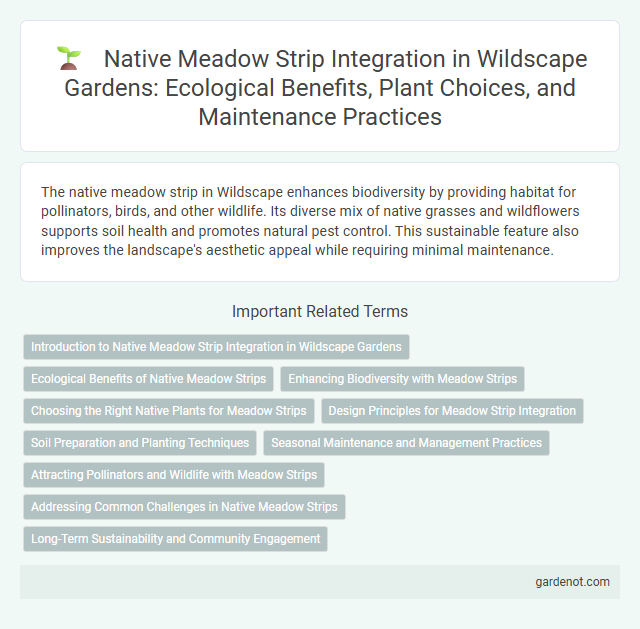The native meadow strip in Wildscape enhances biodiversity by providing habitat for pollinators, birds, and other wildlife. Its diverse mix of native grasses and wildflowers supports soil health and promotes natural pest control. This sustainable feature also improves the landscape's aesthetic appeal while requiring minimal maintenance.
Introduction to Native Meadow Strip Integration in Wildscape Gardens
Native meadow strips in Wildscape gardens enhance biodiversity by incorporating indigenous grasses and wildflowers that support local wildlife and pollinators. These strips create natural habitats that improve soil health and water retention while reducing the need for irrigation and chemical inputs. Integrating native meadow strips fosters sustainable ecosystems and promotes environmental balance within urban and rural landscapes.
Ecological Benefits of Native Meadow Strips
Native meadow strips enhance biodiversity by providing essential habitats for pollinators such as bees, butterflies, and other beneficial insects crucial for ecosystem balance. These strips improve soil health through deep-rooted native grasses and wildflowers, which increase organic matter and reduce erosion. Moreover, native meadow strips contribute to carbon sequestration, supporting climate change mitigation efforts within wildscape restoration projects.
Enhancing Biodiversity with Meadow Strips
Native meadow strips significantly boost local biodiversity by providing essential habitats for pollinators, birds, and small mammals. These strips support diverse wildflowers and grasses that improve soil health, aid in water retention, and attract beneficial insects. Integrating native meadow strips into landscapes creates ecological corridors that enhance species connectivity and resilience.
Choosing the Right Native Plants for Meadow Strips
Selecting the right native plants for a meadow strip enhances biodiversity by supporting local pollinators and wildlife. Prioritize native grasses such as little bluestem (Schizachyrium scoparium) and wildflowers like black-eyed Susan (Rudbeckia hirta) to ensure adaptability and low maintenance. Incorporating a diverse mix of species tailored to regional soil and climate conditions promotes ecosystem resilience and vibrant seasonal displays.
Design Principles for Meadow Strip Integration
Design principles for native meadow strip integration emphasize selecting region-specific native grasses and wildflowers to promote local biodiversity and ecological resilience. Incorporating varied plant heights and bloom periods supports pollinators and beneficial insects throughout the growing season. Strategic placement along field edges and pathways minimizes soil erosion while creating natural wildlife corridors that enhance ecosystem connectivity.
Soil Preparation and Planting Techniques
Native meadow strips require thorough soil preparation, including removal of existing vegetation and loosening the soil to a depth of 15-20 cm to promote root penetration and water infiltration. Planting techniques emphasize using locally sourced native seeds or plugs, sown or planted in early spring or late fall to optimize germination and establishment. Proper seedbed firming and mulching can enhance moisture retention and reduce weed competition, ensuring a thriving native meadow strip.
Seasonal Maintenance and Management Practices
Native meadow strips require seasonal maintenance to promote biodiversity and prevent invasive species from dominating. Regular mowing in late summer helps control woody plant encroachment and encourages wildflower reseeding. Implementing periodic prescribed burns or selective brush removal supports native plant health and enhances habitat quality for pollinators and wildlife.
Attracting Pollinators and Wildlife with Meadow Strips
Native meadow strips are essential for attracting pollinators such as bees, butterflies, and hoverflies by providing a rich diversity of nectar-rich wildflowers. These strips create a vital habitat that supports local wildlife, including birds and beneficial insects, by offering food, shelter, and breeding grounds. Incorporating native plants adapted to the local environment enhances biodiversity and promotes ecological balance within the Wildscape ecosystem.
Addressing Common Challenges in Native Meadow Strips
Native meadow strips enhance biodiversity by supporting pollinators and local wildlife, yet common challenges include invasive species encroachment and soil nutrient imbalances. Effective management involves selecting native species adapted to specific regional conditions and implementing controlled mowing schedules to prevent dominance by aggressive plants. Regular monitoring and adaptive practices ensure long-term sustainability and ecological resilience of native meadow strips.
Long-Term Sustainability and Community Engagement
Native meadow strips enhance long-term sustainability by supporting biodiversity and improving soil health through deep-rooted native plants. These strips foster community engagement by providing educational opportunities and hands-on involvement in conservation efforts, encouraging local stewardship. Collaborative projects integrating native meadows strengthen community bonds and promote ongoing environmental awareness.
Native meadow strip Infographic

 gardenot.com
gardenot.com